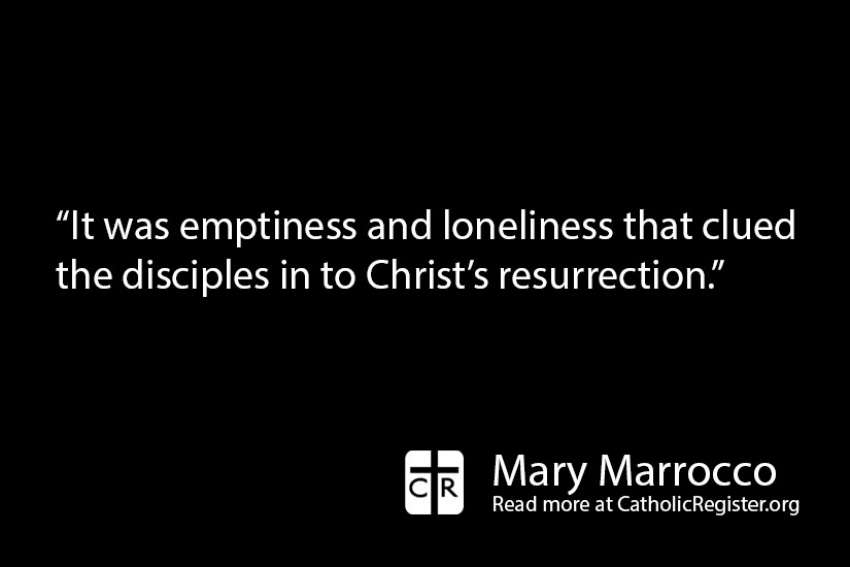I was working in a new place where I knew nobody. During Lent and Holy Week, I’d attended all the services, culminating in the Easter Vigil service the night before. Each was moving and intense. But as the light of paschal dawn broke, I was alone, and felt alone in every way.
Something had happened; death and resurrection had happened; new life and communion had happened. Or had they? Was it all imaginary? Had anything changed, really? Why this bleakness and emptiness, then?
“If this resurrection of Yours is real,” I said aloud without thinking, “you had better prove it!”
Since that morning, the reality of the Resurrection has been shown to me. I’m still capable of doubting, but my spontaneous challenge was met in the flesh. It couldn’t have happened except through the loneliness I experienced then.
Loneliness is a real place and itself a teacher.
There are different kinds of loneliness. We tend to be ashamed and hide our loneliness. Who knows why? It isn’t particularly shameful, though it often seems so.
There’s the anguish of being lonely by circumstance, seeing others surrounded by companions while you, yourself, have nobody. Maybe you never had them, maybe they were taken from you. For the person who’s lonely in this way, the suffering is deep, often hidden and overlooked.
There’s something of an epidemic of this kind of loneliness among us and an urgent call for others to reach out to the lonely one, in Jesus’ exhortation to “welcome the stranger” (Matthew 25:35).
There’s loneliness in marriage, in community life and in singleness. There can be loneliness in accepting one’s vocation, giving leadership or acting with integrity.
A teacher colleague of mine felt lonely at a school staff meeting, speaking up on behalf of having Advent prayer rather than Santa parties before Christmas.
There’s loneliness in living after one’s beloved dies, loneliness in parenthood and even in creativity. I’m not sure which kind of loneliness Dorothy Day was thinking of when she entitled her autobiography The Long Loneliness, but surely she underwent several of them.
A missionary I know remarked once, with wisdom surprising for her youth: “Somebody has to be on the cross for the community. And that’s incredibly lonely.”
Was Jesus lonely there — abandoned by God and humanity — turning for companionship to the thief on the neighbouring cross?
There’s a loneliness at the heart of each of us. Loneliness is a real place inside us, as real as Mount Robson or the Pacific Ocean. Even when we’re happy, engaged and surrounded by friends, we may hear its echo.
Inside us all is a sacred space, and that space can feel like loneliness.
We may protect it by erecting boundaries, laws or fences to ward off others from coming there. Sometimes we need to. Creating boundaries can keep us from creating worse things. But they’re no replacement for respecting and cherishing the sacred space within. Even when that sacred space feels like loneliness or emptiness.
It was emptiness and loneliness that clued the disciples in to Christ’s resurrection. They’d experienced the emptiness of beholding their leader’s broken, battered body, of seeing their hopes and dreams mocked, beaten, nailed and buried. Some knew the long loneliness of keeping vigil there into the dark night. Some knew the loneliness and emptiness of letting their own fears lead to betrayal and fleeing.
Whatever their inner emptiness, the women brought it to His tomb. Whatever they were expecting, it was not that they would be met by more emptiness.
When Mary Magdalene beheld the emptiness of the tomb, she wept. She wept as though it was the same emptiness that was inside her. The loneliness that Jesus’ coming had changed.
Now His going had torn it open again, far more wildly and deeply than before. She dared to feel it, as she’d dared to feel His love.
Perhaps because of that, she was able to feel something new and unexpected. She was able to hear a voice, see a face and feel a presence in the desolation. “Mary,” He said, and she turned.
She discovered that the dreaded emptiness — contained now by the earthen walls of Christ’s tomb — is the opening where the eternal light gets in.
The word of the Resurrection is that the empty space is the doorway to Heaven, the gateway to boundlessness. Our loneliness doesn’t keep us from it, but opens us to it.
It’s a word she and Peter, John, Mary and the other Marys, Cleopas and all the disciples, were unable to keep to themselves. They found it unbearable to keep it locked inside. They had to share it with each other and ultimately take the risk to share it beyond themselves.
What if the loneliness inside us is a vast space, where we can hear a word and see a face? That does change everything.
(Marrocco can be reached at marrocco7@sympatico.ca)


